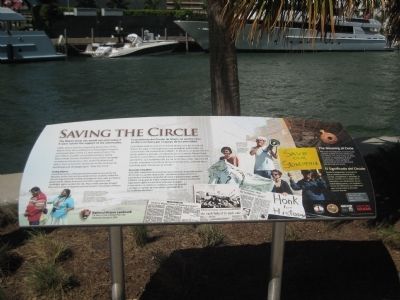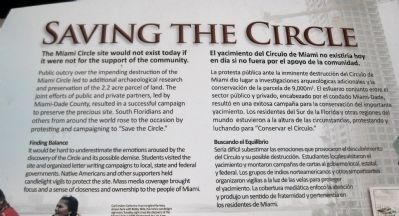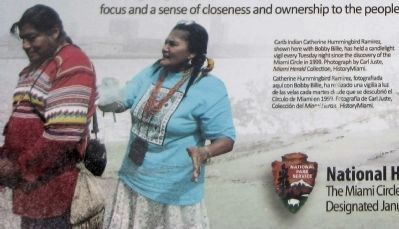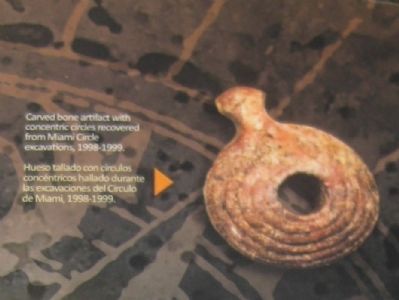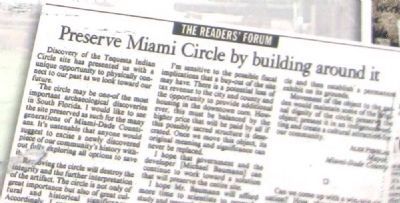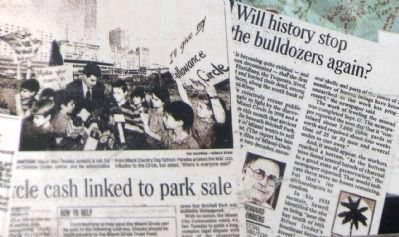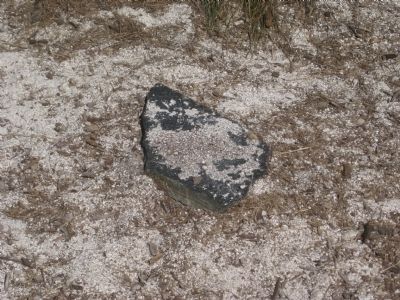Miami in Miami-Dade County, Florida — The American South (South Atlantic)
Saving the Circle
Public outcry over the impending destruction of the Miami Circle led to additional archaeological research and preservation of the 2.2 acre parcel of land. The joint efforts of the public and private partners, led by Miami-Dade County, resulted in a successful campaign to preserve the precious site. South Floridians and others from around the world rose to the occasion by protesting and campaigning to "Save the Circle."
Finding Balance
It would be hard to underestimate the emotions aroused by the discovery of the Circle and its possible demise. Students visited the site and organized letter writing campaigns to local, state and federal governments. Native Americans and other supporters held candlelight vigils to protect the site. Mass media coverage brought focus and a sense of closeness and ownership to the people of Miami.
El yacimiento del Círculo de Miami no existiría hoy en día si no fuera por el apoyo de la comunidad.
La protesta pública ante la inminente destrucción del Círculo de Miami dio lugar a investigaciones arqueológicas adicionales y la conservación de la parcela de 9,000m². El esfuerzo conjunto entre el sector público y privado, encabezado por el condado Miami-Dade, resultó en una exitosa campaña para la conservación del importante yacimiento. Los residented del Sur de la Florida y otras regiones del mundo estuvieron a la altura de las circunstancias, protestando y luchando para "Conservar el Círculo."
Buscando el Equilibrio
Sería difícil subestimar las emociones que provocaron el descubrimiento del Círculo y su posible destrucción. Estudiantes locales visitaron el yacimiento y montaron campañas de cartas al gobierno local, estatal, y federal. Los grupos de indios norteamericanos y otros simpatizantes organizaron vigilias a la luz de las velas para proteger el yacimiento. La cobertura mediática enfocó la atención y produjo un sentido de fraternidad y pertenencia en los residentes de Miami.
(photograph)
Carib Indian Catherine Hummingbird Ramirez, shown here with Bobby Billie, has held a candlelight vigil every Tuesday night since the discovery of the Miami Circle in 1999. Photograph by Carl Juste, Miami Herald Collection, HistoryMiami.
Catherine Hummingbird Ramirez, fotografiada aquí con Bobby Billie, ha realizado una vigilia a luz de las velas cada martes desde que se descubrió el Círculo de Miami en 1999. Fotografía por Carl Juste, Colección del Miami Herald, HistoryMiami.
(photograph)
Demonstrators protest the planned destruction of the Miami Circle. Photograph by C.W. Griffin, Miami Herald Collection, HistoryMiami.
Los manifestantes protestan contra los planes para destruir el Círculo de Miami. Fotografía de C.W. Griffin, Colección del Miami Herald, HistoryMiami.
(photograph)
Carved bone artifact with concentric circles recovered from Miami Circle excavations, 1998-1999.
Hueso tallado con círculos concéntricos hallado durante las excavaciones del Círculo de Miami, 1998-1999.
The Meaning of Circle
The circle has long been an ancient an universal symbol of unity, wholeness, and infinity. The circle is also an object of nature, an idealization of pure mathematics, and a symbol or framework we use to understand and describe our world.
El Significado del Círculo
Desde la antigüedad, el círculo es el símbolo universal de la unidad, completitud, e infinidad. El círculo también es un objeto de la naturaleza, una idealización de las matemáticas puras y un símbolo o marco de referencia que utilizamos para comprender y describir nuestro mundo.
National Historic Landmark
The Miami Circle at Brickell Point Site
Designated January 6, 2009
(images: three newspaper clippings)
· "The Readers' Forum: Preserve Miami Circle by building around it", letter by Alex Penelas, Mayor, Miami-Dade County
· "Circle Cash Linked to Park Sale"
by Herald staff, with photo by Tim Chapman
· "Will history stop the bulldozers again?" by Howard Kleinberg
Miami Circle is a registered trademark of HistoryMiami.
Erected by the Florida Inland Navigation District, the State of Florida Division of Historical Resrouces, and HistoryMiami.
Topics and series. This historical marker is listed in these topic lists: Anthropology & Archaeology • Charity & Public Work • Communications • Government & Politics • Native Americans. In addition, it is included in the National Historic Landmarks series list. A significant historical date for this entry is January 6, 1943.
Location. 25° 46.187′ N, 80° 11.322′ W. Marker is in Miami, Florida, in Miami-Dade County. Marker can be reached from Brickell Avenue (U.S. 1/41) north of Southeast 5th Street, on the right when traveling north. Located in the city's Brickell neighborhood, the marker is inside the Miami Circle park at Brickell Point, across from downtown on the south bank of the Miami River. Brickell Point (not to be confused with Brickell Park, roughly 500 feet to the south) is a short walk east of Fifth Street Station along the Metromover's Brickell loop. Touch for map. Marker is at or near this postal address: 401 Brickell Avenue, Miami FL 33131, United States of America. Touch for directions.
Other nearby markers. At least 8 other
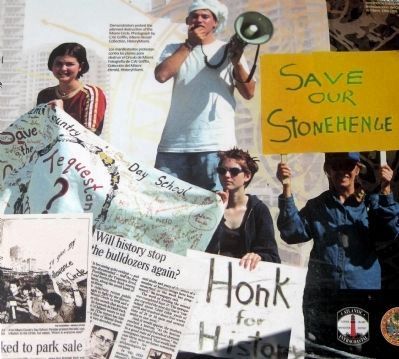
Photographed By AGS Media, March 16, 2013
4. Saving the Circle Marker
More about this marker. The marker stands along the river walk near the park's eastern entrance, overlooking the river's egress into Biscayne Bay.
Along the marker's lower edge appears the logo of the National Park Service, the logos of the marker's sponsors, and a small placard noting the availability of a Miami Circle audio tour via telephone at 305-809-8230. For English, select tour stops 20-26, or for Spanish, 30-36.
Related markers. Click here for a list of markers that are related to this marker. These markers explain the history of the Miami Circle and Brickell Point.
Credits. This page was last revised on June 16, 2016. It was originally submitted on May 22, 2013, by Glenn Sheffield of Tampa, Florida. This page has been viewed 892 times since then and 25 times this year. Photos: 1. submitted on May 22, 2013, by Glenn Sheffield of Tampa, Florida. 2, 3, 4, 5, 6, 7, 8, 9. submitted on May 23, 2013, by Glenn Sheffield of Tampa, Florida. • Craig Swain was the editor who published this page.
